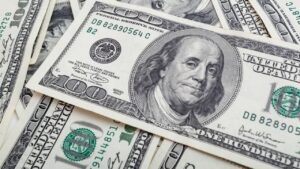
The ICE-calculated index showing the dollar’s dynamics against six currencies (euro, Swiss franc, yen, Canadian dollar, pound and Swedish krone) is losing 0.03% in trading, while the broader WSJ Dollar Index – 0.24%.
Traders are waiting for the publication of the minutes of the Federal Reserve’s (Fed) December meeting, expecting to see signals in it that the U.S. central bank is ready to soften plans to further raise the benchmark interest rate amid weakening global economic activity, Market Watch notes.
The Fed raised the rate by 50 basis points (bps) to 4.25-4.5% per annum in December, while at the previous four meetings it had increased by 75 bps. At the same time, Fed Chairman Jerome Powell said that the U.S. Central Bank will raise the rate until it reaches its inflation targets.
“While the Fed plans to keep rates high longer than previously expected, markets continue to resist, still expecting policy easing,” High-Frequency Economics experts Rubila Farooqui and John Sylvia said in a review. – We don’t expect the Fed to move to a rate cut this year.”
The minutes of the Fed’s December meeting will be released Wednesday at 9:00 p.m. Q.
As of 8:05 a.m. QE Wednesday, the euro/dollar pair is trading at $1.0573, up from $1.0550 at the close of the previous session. The pound/dollar exchange rate is at $1.1986 against $1.1967 the day before.
The U.S. currency pair with the yen dropped to 130.8 yen from 131.01 yen during the previous trading session.
The dollar-yuan exchange rate declined during trading to 6.8919 yuan against 6.9151 yuan the day before.
EURO, pound, U.S. dollar, yen
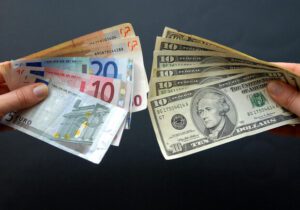
Tuesday the U.S. dollar is almost stable against the European currency and is declining against the yen.
The DXY index, which shows the U.S. dollar value against the six major world currencies, added 0.1% during the session. At the same time, indicator WSJ Dollar, which tracks the movement of the dollar against 16 currencies, dropped by a similar amount.
The euro was trading at $1.0664 against $1.0668 at the end of the previous session.
The value of the single European currency is now around 138.81 yen, compared to 139.46 yen on Monday. The dollar exchange rate is 130.18 yen against 130.74 yen at the end of the previous trading day.
The pound is trading at $1.2069 compared to $1.2048 on the previous trading day and the euro is at £0.8835 compared to £0.8856.
The euro gained 8.8 percent against the dollar in the fourth quarter of 2022, according to Dow Jones Market Data. This was the highest quarterly gain since 2010.
Meanwhile, the DXY index showed a 7.7% drop in October-December, the biggest decline in twelve years. That didn’t stop the indicator from ending 2022 on the plus side: it was up 7.9%, the highest gain since 2015.
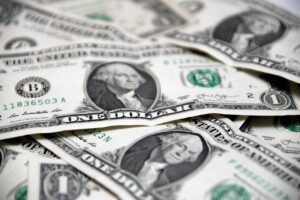
The U.S. dollar is weak against the euro in trading on Friday, stable against the pound and getting cheaper against the yen.
The calculated ICE index, which shows the dollar’s movement against six currencies (euro, Swiss franc, yen, Canadian dollar, pound sterling and Swedish krona), is adding 0.14% in trading, while the broader WSJ Dollar Index is stable.
The ICE Dollar Index, which rose in September to its highest level in 20 years, has since declined 10%. Nevertheless, the index ends 2022 up more than 8%.
As of 8:05 a.m. Ksk on Friday, the euro/dollar pair was trading at $1.0650 compared to $1.0664 at the close of the previous session. The exchange rate of the pound to the dollar is $1.2050 against $1.2055 the day before.
The value of the U.S. currency in a pair with the yen dropped to 132.55 yen, compared to 133.03 yen in previous trading.
The Bank of Japan continues unscheduled redemption of government bonds on Friday for the third consecutive day in an effort to curb the growth of bond yields, Bloomberg reported. This month the volume of redemption of government bonds by the Japanese Central Bank has reached a record level of 17 trillion yen ($128 billion).
The Bank of Japan unexpectedly expanded the boundaries of the corridor of permissible fluctuations in yields of ten-year government bonds at the December meeting that was perceived by the market as a step towards easing its policy.
“We believe that the Japanese Central Bank is experiencing difficulties with its policy of yield control and in the end it will have to abandon it – this is a key factor in strengthening the yen,” notes Rodrigo Catherill, a currency market analyst at National Australia Bank Ltd. in Sydney.
The expert expects the dollar to yen to 120 yen in 2023.
EURO, pound, U.S. dollar, yen
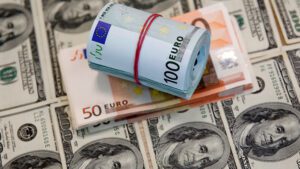
The U.S. dollar is getting cheaper against the euro, the yen and the pound sterling on Thursday amid weak trading activity in the last days of the year.
The calculated ICE index, which shows the dollar’s dynamics against six currencies (euro, Swiss franc, yen, Canadian dollar, pound sterling and Swedish krona), lost 0.15% in trading, while the broader WSJ Dollar Index lost 0.2%.
The ICE Dollar Index, which rose in September to its highest level in 20 years, has since declined 10%. Nevertheless, the index ends 2022 up nearly 9%.
The euro/dollar pair is trading at $1.0623 as of 7:45 a.m. Ksk on Thursday, up from $1.0613 at the close of the previous session. The exchange rate of the pound to the dollar is $1.2041 against $1.2021 the day before.
The U.S. currency went down to 133.73 yen against 134.48 yen at the previous trading session.
The situation in China remains in the focus of traders. The optimism caused by expectations of increased business activity in China after the lifting of the quarantine restrictions was replaced with fears of a new wave of COVID-19 disease in the world.
Earlier Beijing declared about its intention to soften the epidemiological requirements for those arriving to the country since January 8. In addition, the Chinese authorities will resume issuing documents for tourists wishing to travel abroad. The U.S. and Italy have already announced additional requirements for passengers arriving from China.
The exchange rate of the dollar paired with the yuan dropped to 6.9721 yuan/$1 in trading on Thursday from 6.9787 yuan/$1 the day before.
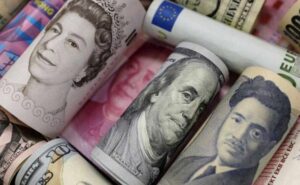
The US dollar rate was changing little against the euro and the pound during the Wednesday morning session, but demonstrated a considerable rise against the yen amid increasing US government bond yields.
The ICE-calculated index showing the U.S. dollar’s performance against six currencies (euro, Swiss franc, yen, Canadian dollar, pound sterling and Swedish krona) is up 0.1%, as is the broader WSJ Dollar Index.
The dollar/yen exchange rate is up 0.4 percent at 134.08 yen as of 7:48 a.m. ksk, up from 133.50 yen at the end of last session.
The yield on 10-year U.S. government bonds on Wednesday morning is about 3.85%, the highest since early November. The rise in yields is due to fears that China’s successive easing of anti-coverage restrictions could intensify global inflationary pressures, Trading Economics writes.
The dollar also continues to receive support from the Federal Reserve’s (Fed) hawkish mood. The Fed expects to raise its key interest rate to 5-5.25% over the next year and hold it at that level until at least early 2024 to return inflation to its 2% target.
The U.S. rate now stands at 4.25-4.5%, meaning the Fed plans three more hikes of 25 basis points. Many market participants expected the final rate level to be lower and were hoping for a reversal in the Fed’s monetary policy and a rate cut at some point next year.
The euro/dollar pair is trading at $1.0645 versus $1.0642 at the close of Tuesday’s session.
The pound sterling is losing less than 0.1% and is trading at $1.2026 versus $1.2031 the day before.
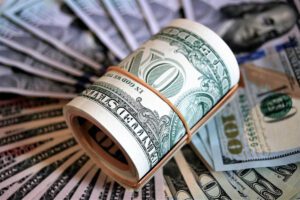
The U.S. dollar is getting cheaper against the euro, is stable against the pound and getting stronger against the yen.
Traders are focusing on the November U.S. Commerce Department report on Americans’ income and spending, which includes the dynamics of the Consumer Price Index (PCE and Core PCE) closely monitored by the Federal Reserve (Fed).
The Core PCE core inflation index, which excludes changes in food and energy prices, rose 0.2 percent in November from the previous month, the same as in October, experts polled by Dow Jones and The Wall Street Journal predicted. In annual terms, the index increase is expected to slow to 4.6% from 5% a month earlier.
On the eve of the U.S. Department of Commerce significantly improved its estimate of U.S. GDP growth in the third quarter – up to 3.2% in annualized terms from the previously announced 2.9%. This supported the dollar as traders took it as a signal that the Fed will raise the rate higher than expected to curb economic activity and inflationary pressures, Trading Economics said.
The euro/dollar pair was trading at $1.0610 as of 7:50 a.m. Friday versus $1.0598 at the close of the previous session.
The pound to dollar rate was at $1.2043 against $1.2045 the day before.
The value of the U.S. currency in a pair with the yen rose to 132.69 yen against 132.35 yen in previous trading.
Statistics from Japan, released on Friday, showed an acceleration in overall inflation in the country in November to 3.8% on an annualized basis – the highest since January 1991.
Consumer prices excluding fresh food (a key indicator tracked by the Bank of Japan) rose 3.7% year on year last month after climbing 3.6% in September. The rate of growth was the fastest since December 1981. In doing so, the figure exceeded the country’s central bank’s 2% target for the eighth month in a row.
The ICE-calculated index showing the dollar’s performance against six currencies (euro, Swiss franc, yen, Canadian dollar, pound sterling and Swedish krona) lost 0.06% in trading, while the broader WSJ Dollar Index lost 0.02%.